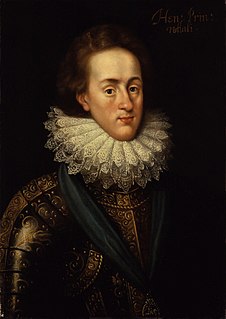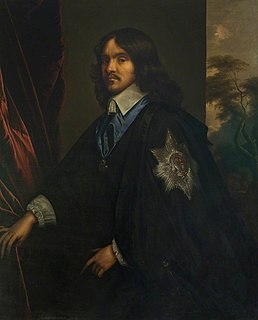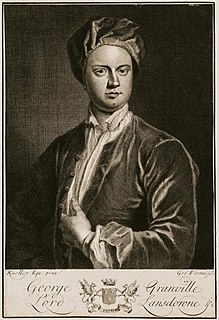
The Long Parliament was an English Parliament which lasted from 1640 until 1660. It followed the fiasco of the Short Parliament, which had convened for only three weeks during the spring of 1640 after an 11-year parliamentary absence. In September 1640, King Charles I issued writs summoning a parliament to convene on 3 November 1640. He intended it to pass financial bills, a step made necessary by the costs of the Bishops' Wars in Scotland. The Long Parliament received its name from the fact that, by Act of Parliament, it stipulated it could be dissolved only with agreement of the members; and those members did not agree to its dissolution until 16 March 1660, after the English Civil War and near the close of the Interregnum.

Henry Frederick, Prince of Wales, was the eldest son and heir apparent of James VI and I, King of England and Scotland; and his wife Anne of Denmark. His name derives from his grandfathers: Henry Stuart, Lord Darnley; and Frederick II of Denmark. Prince Henry was widely seen as a bright and promising heir to his father's thrones. However, at the age of 18, he predeceased his father when he died of typhoid fever. His younger brother Charles succeeded him as heir apparent to the English, Irish, and Scottish thrones.

William Hamilton, 2nd Duke of Hamilton KG was a Scottish nobleman who supported both Royalist and Presbyterian causes during the Wars of the Three Kingdoms.

Archibald Campbell, 1st Marquess of Argyll, 8th Earl of Argyll, Chief of Clan Campbell was a Scottish nobleman, politician, and peer. The de facto head of Scotland's government during most of the conflict of the 1640s and 50s known as the Wars of the Three Kingdoms, he was a major figure in the Covenanter movement that fought for the maintenance of the Presbyterian religion against the Stuart monarchy's attempts to impose episcopacy. He is often remembered as the principal opponent of the royalist general James Graham, 1st Marquess of Montrose.

Richard Lumley, 1st Earl of Scarbrough, was an English soldier and statesman best known for his role in the Glorious Revolution.

Sir Robert Munro of Foulis, 6th Baronet was a soldier-politician whose life followed an 18th-century pattern. He fought in support of the Revolution Settlement and the House of Hanover, and their opposition to all attempts by the Jacobites to restore the House of Stuart either by force of arms or by political intrigue. He was killed at the Battle of Falkirk Muir in 1746.

George Granville, 1st Baron Lansdowne PC, of Stowe, Cornwall, was an English Tory politician who sat in the English and British House of Commons from 1702 until 1712, when he was raised to the peerage as Baron Lansdown and sat in the House of Lords. He was Secretary at War during the Harley administration from 1710 to 1712. He was also a noted poet and made a name for himself with verses composed on the visit of Mary of Modena, then Duchess of York, while he was at Cambridge in 1677. He was also a playwright, following in the style of John Dryden.

Clan Murray is a Highland Scottish clan. The chief of the Clan Murray holds the title of Duke of Atholl. Their ancestors who established the family in Scotland in the 12th century were the Morays of Bothwell. In the 16th century descendants of the Morays of Bothwell, the Murrays of Tullibardine, secured the chiefship of the clan and were created Earls of Tullibardine in 1606. The first Earl of Tullibardine married the heiress to the Stewart earldom of Atholl and Atholl therefore became a Murray earldom in 1626. The Murray Earl of Atholl was created Marquess of Atholl in 1676 and in 1703 it became a dukedom. The marquess of Tullibardine title has continued as a subsidiary title, being bestowed on elder sons of the chief until they succeed him as Duke of Atholl.

James II and VII was King of England and King of Ireland as James II, and King of Scotland as James VII from the death of his elder brother, Charles II, on 6 February 1685. He was deposed in the Glorious Revolution of 1688. He was the last Catholic monarch of England, Scotland, and Ireland. His reign is now remembered primarily for struggles over religious tolerance, however, it also involved struggles over the principles of absolutism and the divine right of kings. His deposition ended a century of political and civil strife by confirming the primacy of Parliament over the Crown.
Robert I de Brus, 1st Lord of Annandale was an early-12th-century Anglo-Norman lord and the first of the Bruce dynasty to hold lands in Scotland. A monastic patron, he is remembered as the founder of Gisborough Priory in Yorkshire, England, in present-day Redcar and Cleveland, in 1119.
Malise Graham was a 15th-century Scottish magnate, who was the heir to the Scottish throne between 1437 and 1451, if Elizabeth Mure's children were not counted as lawful heirs.

Lieutenant-General Emanuel Scrope Howe, of The Great Lodge, Alice Holt Forest, Hampshire, was an English diplomat, army officer, and Member of Parliament.

The Restoration was the return of the monarchy to Scotland in 1660 after the period of the Commonwealth, and the subsequent three decades of Scottish history until the Revolution and Convention of Estates of 1689. It was part of a wider Restoration in the British Isles that included the return of the Stuart dynasty to the thrones of England and Ireland in the person of Charles II.
Sir Thomas Lyon, Master of Glamis was a Scottish nobleman and official, Lord High Treasurer of Scotland.

Sir John Menteith of Ruskie and Knapdale was a Scottish nobleman during the Wars of Scottish Independence. He is known for his capture of Sir William Wallace in 1305 and later joined with King Robert I of Scotland and received large land grants in Knapdale and Kintyre for his service. He is described as "guardian" of the Earldom of Menteith, as his great-nephew Alan II, Earl of Menteith was a minor at the time of the death of Alan I, Earl of Menteith.

Sir Bevil Granville was an English soldier who served as Governor of Pendennis Castle in Cornwall and as Governor of Barbados.
Robert Hamilton (1650–1701), second baronet of Preston, was one of the leaders of the Scottish Covenanters. He was the son of Sir Thomas Hamilton, and brother of Sir William, first baronet of Preston. Hamilton was educated at Glasgow University under Professor Burnet. He attached himself to the cause of the Covenanters, and appears in command at Drumclog and Bothwell Brig. After the defeat he retired to Holland, where he remained with his brother-in-law, Gordon of Earlston, till the Revolution of 1688. He declined to recognise title of Prince of Orange, on the ground that he was not a Covenanted sovereign. He was arrested in Edinburgh for being concerned in the second Sanquhar Declaration of August, 1692, issued by the "United Societies". On liberation, he left his testimony afresh against backsliding in Church and State, and becomes as far as one person could be the main stay of "the afflicted Remnant." He died, unmarried, aged 51.

James Grahme or Graham (1649–1730) was an English army officer, courtier, politician who sat in the English and British House of Commons between 1685 and 1727. After the Glorious Revolution he was involved for ten years in Jacobite schemes and plots.
Robert Melville, 1st Lord Melville was a Scottish diplomat, administrator, jurist, and intriguer, and uncle of the poet Elizabeth Melville.
Sir James Sandilands was a courtier to King James VI and I and captain of Blackness Castle













